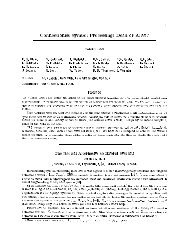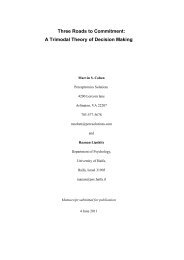Three Roads to Commitment: A Trimodal Theory of Decision Making
Three Roads to Commitment: A Trimodal Theory of Decision Making
Three Roads to Commitment: A Trimodal Theory of Decision Making
Create successful ePaper yourself
Turn your PDF publications into a flip-book with our unique Google optimized e-Paper software.
<strong>Three</strong> <strong>Roads</strong> <strong>to</strong> <strong>Commitment</strong>: A <strong>Trimodal</strong> <strong>Theory</strong> <strong>of</strong> <strong>Decision</strong> <strong>Making</strong> 5<br />
and across time. 1<br />
Intentions, because they are dispositions <strong>to</strong> act in future, can be thought <strong>of</strong> as implicitly conditional, i.e., an<br />
intention <strong>to</strong> do A if C. Both actions A and conditions C may be fuzzy and even somewhat indeterminate (for<br />
example, a vague commitment <strong>to</strong> the value <strong>of</strong> helping others whenever the opportunity arises), and need not be<br />
easily articulated. Both the acts and the conditions for acting may vary in specificity and in temporal scope. For<br />
example, the activity <strong>of</strong> being a doc<strong>to</strong>r is significantly more general and slightly more extended than the activity <strong>of</strong><br />
practicing a particular medical specialty. Both <strong>of</strong> these, in turn, are more general than the action <strong>of</strong> using treatment<br />
method A, whose temporal scope is distributed among discrete events whose occurrence is conditioned on specific<br />
intervals (e.g., while the doc<strong>to</strong>r is in charge <strong>of</strong> a patient with condition X). This intention, in turn, is more general<br />
than the action <strong>of</strong> using a cus<strong>to</strong>mized variant <strong>of</strong> treatment method A, which begins and ends within the single short<br />
interval <strong>of</strong> care for a single patient. Specificity and temporal scope need not be negatively related. An intention may<br />
include parts that are also intentions, e.g., a plan may include a series <strong>of</strong> treatments for a particular patient<br />
contingent on results at each stage, which is both more specific and more temporally extended than a plan for a<br />
single treatment. An action may also be an intended aspect or feature <strong>of</strong> another action. For example, Dr. House<br />
might intend <strong>to</strong> minimize unnecessary tests and interventions throughout his medical practice. Intentions such as<br />
these can spread either formally or informally, becoming medical pro<strong>to</strong>cols or standards <strong>to</strong> be followed throughout a<br />
pr<strong>of</strong>ession. Cultural traditions and norms evolve over longer periods <strong>of</strong> time and spread even more widely. In more<br />
uncharted and non-traditional regions <strong>of</strong> practical decision making, however, specificity and scope do tend <strong>to</strong> trade<br />
<strong>of</strong>f: The larger the temporal scope <strong>of</strong> an intended activity, and the more general or temporally extensive its<br />
1 This implies empirically testable claims: that commitment induces characteristics (a) through (e), and that, as a<br />
result, these characteristics co-occur. These predictions can be tested, for example, by methods developed in<br />
research on prospective memory (McDaniel & Einstein, 2007; Kliegel, McDaniel, & Einstein, 2009). Prospective<br />
memory is defined by Goschke & Kuhl (1996) as the representation <strong>of</strong> an action <strong>to</strong> which the decision maker is<br />
committed and that plays a causal role in performance <strong>of</strong> the action. They developed an experimental paradigm in<br />
which participants learn two scripts under exactly the same conditions; they are then <strong>to</strong>ld which one <strong>of</strong> the two they<br />
will have <strong>to</strong> act on. When tested after intent formation but before execution, memory is better for the script<br />
corresponding <strong>to</strong> the active intention, despite equal exposure, learning incentives, and distractions. Moreover, the<br />
advantage disappears when memory for the two scripts is compared after the intended script has been implemented.<br />
To test item (b) above, the paradigm could be modified <strong>to</strong> test recognition <strong>of</strong> new information that is relevant <strong>to</strong> two<br />
plans, one intended and one not, rather than verbatim script text. For item (c), the competence and completeness <strong>of</strong><br />
spelling out plans, e.g., for contingencies, could be compared for two tasks, one intended for execution and one not.<br />
To test resistance <strong>to</strong> revision (a), willingness <strong>to</strong> change a plan in light <strong>of</strong> disconfirming information could be<br />
compared in the two cases.




